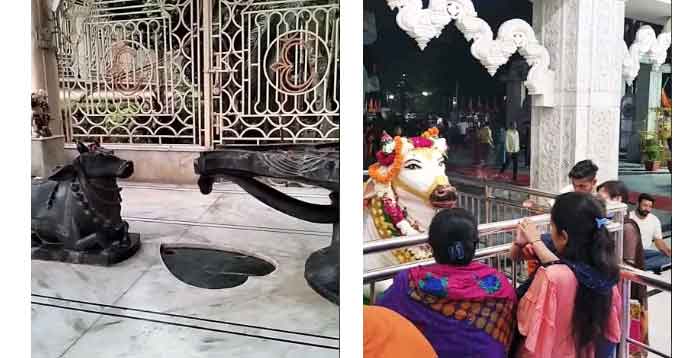INVC NEWS
Kashi : Have you ever wondered why Nandi, the loyal bull, always sits facing the Shivlinga in Shiva temples? This fascinating positioning isn’t just a random choice. It’s rooted deeply in ancient Hindu mythology and carries profound spiritual significance. Let’s delve into the story behind Nandi and uncover why this beloved figure always has his gaze fixed on the divine symbol of Shiva.
Importance of Nandi in Shiva Temples
Every Shiva temple you visit, you’ll find Nandi stationed right in front of the Shivlinga. This isn’t merely for aesthetic purposes but is a crucial aspect of temple architecture and spirituality. Nandi represents unwavering devotion and the ultimate bond between a devotee and the divine.
The Legend of Nandi
Origin of Nandi
Nandi, often depicted as a mighty bull, has his origins steeped in mythology. He was born from the union of the sage Shilada and the divine cow, Surabhi. Shilada performed severe penance to have a divine child, and thus Nandi was born, destined to serve Lord Shiva.
The Mythical Story Behind Nandi’s Devotion
According to the legends, once, there was a great churning of the ocean by the gods and demons, known as the Samudra Manthan. Among the treasures and poisons that emerged, a deadly poison, Halahal, threatened to destroy all life. Lord Shiva, in his infinite compassion, drank the poison to save the universe. Some drops of this poison fell on the ground, and Nandi, showing his boundless devotion, licked it up without hesitation, further cementing his bond with Shiva.
Nandi’s Role in the Churning of the Ocean
Nandi’s selfless act during the Samudra Manthan didn’t just save the universe but also showcased his unparalleled devotion. This act of bravery and loyalty earned him the title of Shiva’s greatest devotee, and he was given a prominent place in Shiva’s temples.
Nandi’s Position in Shiva Temples
Significance of Nandi Facing the Shivlinga
The positioning of Nandi facing the Shivlinga is highly symbolic. It represents the ideal devotee’s gaze, fixed unwaveringly on the divine. This placement is a constant reminder to devotees of the focus and dedication required in their spiritual practice.
Symbolism of Nandi’s Placement
Nandi’s placement directly in front of the Shivlinga signifies his role as the gatekeeper and the intermediary between the devotees and Lord Shiva. This position highlights his importance and the respect he commands in the spiritual hierarchy.
Nandi and the Spiritual Connection
Nandi as a Symbol of Devotion and Loyalty
Nandi is more than just a guardian of Shiva’s abode; he is the epitome of devotion and loyalty. His unwavering gaze towards Shiva symbolizes the ultimate surrender a devotee should aspire to achieve.
Nandi and the Soul-Body Relationship
In Hindu philosophy, Nandi’s position represents the soul’s connection to the body. Just as Nandi’s focus is on Shiva, the soul should always be attuned to the divine, despite the distractions of the physical world.
Lessons from Nandi’s Positioning
Nandi’s ever-watchful stance teaches us the importance of steadfastness and devotion. It’s a lesson in maintaining focus on our spiritual goals amidst the chaos of everyday life.
The Belief of Whispering Wishes to Nandi
Origins of the Tradition
The tradition of whispering wishes into Nandi’s ear dates back to ancient times. It’s believed that Nandi, being Shiva’s closest attendant, has the power to convey these wishes directly to the deity.
How to Whisper Wishes to Nandi
Devotees believe that if they whisper their desires into Nandi’s ear with a pure heart, those wishes are more likely to be granted by Lord Shiva. This act is seen as a direct communication channel to the divine.
Nandi as an Intermediary to Lord Shiva
Nandi’s role as an intermediary is crucial. He not only guards Shiva’s abode but also serves as a conduit for devotees to communicate with the Lord, making him an essential figure in Hindu worship.
Nandi in Modern Devotion
Continuing Traditions
Despite the passage of time, the traditions surrounding Nandi continue to thrive. Devotees across the world still practice the ritual of whispering their wishes, maintaining a timeless connection to this ancient belief.
Nandi in Contemporary Worship Practices
In contemporary worship, Nandi remains a powerful symbol of faith and devotion. Modern practices still emphasize his importance, ensuring that his legacy endures in the hearts of devotees.
Conclusion
Nandi’s constant gaze towards the Shivlinga is a profound symbol of devotion and loyalty. His presence in Shiva temples serves as a reminder of the unwavering focus required on our spiritual journey. From ancient legends to modern practices, Nandi’s story continues to inspire and guide devotees towards a deeper connection with the divine.
FAQs
Why is Nandi always placed facing the Shivlinga?
Nandi is always placed facing the Shivlinga to symbolize unwavering devotion and the direct connection between the devotee and Lord Shiva.
What is the significance of Nandi in Hindu mythology?
Nandi represents ultimate loyalty and devotion. He is considered Shiva’s greatest devotee and serves as an intermediary between devotees and the deity.
How did Nandi become Shiva’s greatest devotee?
Nandi became Shiva’s greatest devotee through his selfless act of consuming the poison that spilled during the Samudra Manthan, showcasing his immense loyalty and bravery.
What are the rituals associated with Nandi in temples?
Rituals include whispering wishes into Nandi’s ear, which is believed to be a direct way to communicate desires to Lord Shiva.
Can anyone whisper their wishes to Nandi?
Yes, anyone can whisper their wishes to Nandi, provided they do so with a pure heart and genuine intentions.
















